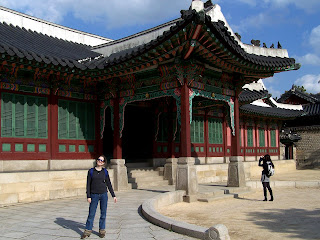
Two weeks ago, after the long-awaited end of our collective GRE travails, Nana and I spent the afternoon at Changdeokgung, one of the Five Grand Palaces of Joseon-era Seoul. (We've already visited three others: Gyeongbokgung, Deoksugung, and Changgyeonggung.) (Previous posts: 1, 2, 3)
Of the Five Grand Palaces, Changdeokgung isn't the grandest--that distinction belongs to Gyeongbokgung, Seoul's downsized version of the Forbidden City and the traditional seat of government during the Joseon Dynasty. Changdeokgung, however, is the only one of the five that's a UNESCO World Heritage Site--along with the Jongmyo Shrine, the only one in Seoul.
Whereas Gyeongbokgung, the ceremonial heart of the Joseon kingdom, was built to impress the stream of official visitors he received there (with the exception of the emissaries of the Chinese emperor, who were deliberately underwhelmed), Changdeokgung was built as an urban retreat for the Joseon royal family, and is still today the largest swath of greenspace in downtown Seoul (that isn't a mountain, of course).
Check out the photos below.
 First, some gratuitous shots of the sky, which was perfectly cooperative--golden light, white clouds on bright blue. The tree above it a ginkgo. They're all over the place here, and the two weeks of brilliant yellow they give you in early November almost make it worth the horrible stench of their fruit.
First, some gratuitous shots of the sky, which was perfectly cooperative--golden light, white clouds on bright blue. The tree above it a ginkgo. They're all over the place here, and the two weeks of brilliant yellow they give you in early November almost make it worth the horrible stench of their fruit.Another cooperative sky below. Note the lack of color in the architecture: one of the Joseon kings built this residential complex for his wife's family, who specifically requested that their place be done in the country style. Most Joseon-era buildings in Seoul, as well as most Joseon-era temples throughout Korea, are famously colorful.
 Here's another shot of the same building. The effect is very Japanese.
Here's another shot of the same building. The effect is very Japanese. The Chinese are associated with red and blue or red and gold; the Japanese with black and bare brown wood (except for the Chinese-style Buddhist temples); and the Koreans for an explosion of greens, pinks, whites, reds, and blues. The buildings below are unmistakeably Korean.
The Chinese are associated with red and blue or red and gold; the Japanese with black and bare brown wood (except for the Chinese-style Buddhist temples); and the Koreans for an explosion of greens, pinks, whites, reds, and blues. The buildings below are unmistakeably Korean. 

In this next shot you can see the main throne hall of Changdeokgung. Just to give you a sense of the scale, the doors are a little less than twice the height of a grown man. The raised path in the foreground is for the king's exclusive use (except for when an emissary of the Chinese emperor came to visit, in which case the emissary would walk the high road with the Joseon king behind and to the side). The little tablets mark the positions various officials were expected to take during royal ceremonies.

Below is the Joseon king's office building, a short walk from the main throne hall. Note the deep blue tiles of the roof--these were a symbol of the Joseon royal family, just as the golden tiles in the Forbidden City symbolize the imperial family of China. To this day, the president of the Republic of Korea lives and works in the Blue House, under a blue roof.
 Changdeokgung rivalled Gyeongbukgung as the king's primary residence during the late Joseon period, and along with Deoksugung, which features a Western-style reception hall, Changdeokgung was the Joseon dynasty's preferred site for meetings with Western emissaries. As a result, the sedan port was widened into a modern driveway to accomodate Western-syle coaches and, later, cars.
Changdeokgung rivalled Gyeongbukgung as the king's primary residence during the late Joseon period, and along with Deoksugung, which features a Western-style reception hall, Changdeokgung was the Joseon dynasty's preferred site for meetings with Western emissaries. As a result, the sedan port was widened into a modern driveway to accomodate Western-syle coaches and, later, cars.
One of the cool things about Changdeokgung is that, unlike almost any other historical site in Korea, an attempt has been made to make parts of Changdeokgung look like they did while the palace was in use. The late Joseon kings used the room below for receiving Western dignitaries.

And the bench below, wildly tricked-out with mother-of-pearl, was the queen's showiest seat.
 The real attraction of Changdeokgung for most visitors, however, is the Secret Garden. Below is the royal library (drool . . .) perched above a neatly manicured koi pond.
The real attraction of Changdeokgung for most visitors, however, is the Secret Garden. Below is the royal library (drool . . .) perched above a neatly manicured koi pond. Nana was somewhat unimpressed with the Biwon, but it did provide some wonderful photo ops.
Nana was somewhat unimpressed with the Biwon, but it did provide some wonderful photo ops. The fall foliage made the scene particularly nice.
The fall foliage made the scene particularly nice. And our final treat, on the way out: Nana mugs in front of a half-millennia-old juniper tree.
And our final treat, on the way out: Nana mugs in front of a half-millennia-old juniper tree. Nana: "Come on--you have to. It's a five-hundred-year-old tree!"
Nana: "Come on--you have to. It's a five-hundred-year-old tree!"And still fragrant.

No comments:
Post a Comment